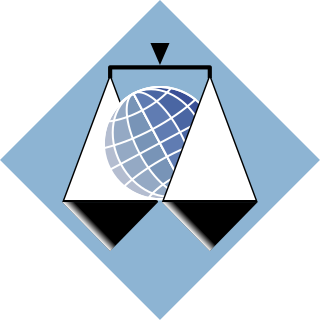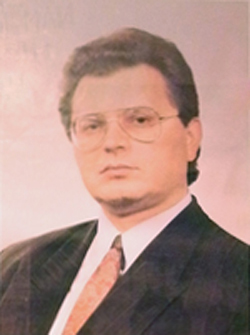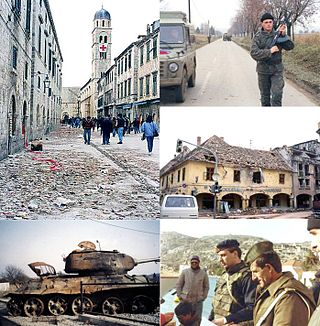
The International Criminal Tribunal for the former Yugoslavia (ICTY) was a body of the United Nations that was established to prosecute the war crimes that had been committed during the Yugoslav Wars and to try their perpetrators. The tribunal was an ad hoc court located in The Hague, Netherlands.

Milan Babić was a Croatian Serb politician and war criminal who served as the first president of the Republic of Serbian Krajina, a self-proclaimed state largely populated by Serbs of Croatia that wished to break away from Croatia during the Croatian War of Independence.

The Republic of Serbian Krajina or Serb Republic of Krajina, known as the Serbian Krajina or simply Krajina, was a self-proclaimed Serb proto-state, a territory within the newly independent Republic of Croatia, which it defied, and which was active during the Croatian War of Independence (1991–95). It was not recognized internationally. The name Krajina ("Frontier") was adopted from the historical Military Frontier of the Habsburg monarchy (Austria-Hungary), which had a substantial Serb population and existed up to the late 19th century. The RSK government waged a war for ethnic Serb independence from Croatia and unification with the Federal Republic of Yugoslavia and Republika Srpska.

The Battle of Vukovar was an 87-day siege of Vukovar in eastern Croatia by the Yugoslav People's Army (JNA), supported by various paramilitary forces from Serbia, between August and November 1991. Before the Croatian War of Independence the Baroque town was a prosperous, mixed community of Croats, Serbs and other ethnic groups. As Yugoslavia began to break up, Serbia's President Slobodan Milošević and Croatia's President Franjo Tuđman began pursuing nationalist politics. In 1990, an armed insurrection was started by Croatian Serb militias, supported by the Serbian government and paramilitary groups, who seized control of Serb-populated areas of Croatia. The JNA began to intervene in favour of the rebellion, and conflict broke out in the eastern Croatian region of Slavonia in May 1991. In August, the JNA launched a full-scale attack against Croatian-held territory in eastern Slavonia, including Vukovar.

The Croatian War of Independence was fought from 1991 to 1995 between Croat forces loyal to the Government of Croatia—which had declared independence from the Socialist Federal Republic of Yugoslavia (SFRY)—and the Serb-controlled Yugoslav People's Army (JNA) and local Serb forces, with the JNA ending its combat operations in Croatia by 1992. In Croatia, the war is primarily referred to as the "Homeland War" and also as the "Greater-Serbian Aggression". In Serbian sources, "War in Croatia" and (rarely) "War in Krajina" are used.
The Vukovar massacre, also known as the Vukovar hospital massacre or the Ovčara massacre, was the killing of Croatian prisoners of war and civilians by Serb paramilitaries, to whom they had been turned over by the Yugoslav People's Army (JNA), at the Ovčara farm southeast of Vukovar on 20 November 1991, during the Croatian War of Independence. The massacre occurred shortly after Vukovar's capture by the JNA, Territorial Defence (TO), and paramilitaries from neighbouring Serbia. It was the largest massacre of the Croatian War of Independence.
Operation Labrador was a false flag operation carried out by the Yugoslav Air Force's Counterintelligence Service (KOS) in the Croatian capital city of Zagreb during the early stages of the Croatian War of Independence. It was devised as a series of terrorist attacks intended to create an image of Croatia as a pro-fascist state. Two bombings were carried out on 19 August 1991, with one at the Jewish Community Centre and a second near Jewish graves at the Mirogoj Cemetery; there were no casualties. Additional attacks targeted the national railway network and were designed to implicate the Croatian President. Operation Labrador was complemented by Operation Opera — a propaganda campaign devised by the KOS to feed disinformation to the media.
The Lovas killings involved the killing of 70 Croat civilian residents of the village of Lovas between 10 and 18 October 1991, during the Croatian War of Independence. The killings took place during and in the immediate aftermath of the occupation of the village by the Yugoslav People's Army (JNA) supported by Croatian Serb forces and Dušan Silni paramilitaries on 10 October, two days after Croatia declared independence from Yugoslavia. The occupation occurred during the Battle of Vukovar, as the JNA sought to consolidate its control over the area surrounding the city of Vukovar. The killings and abuse of the civilian population continued until 18 October, when troops guarding a group of civilians forced them to walk into a minefield at gunpoint and then opened fire upon them.
The Škabrnja massacre was the killing of 62 Croatian civilians and five prisoners of war by Serbian Autonomous Oblast Krajina Territorial Defence troops and the Yugoslav People's Army (JNA) in the villages of Škabrnja and Nadin east of Zadar on 18–19 November 1991, during the Croatian War of Independence. The massacre occurred shortly after an agreement to evacuate Zadar's JNA garrison following an increase in fighting between the Croatian National Guard and the JNA. Most of the killings were committed by SAO Krajina troops which followed the leading armoured JNA units fighting their way into Škabrnja on 18 November. During the initial attack, the attacking force employed a human shield of captured civilians forced to walk in front of armoured vehicles. Most of the civilian population fled the village and about 120–130 were captured by the JNA and detained in the village school and kindergarten. However, others who took shelter in basements were killed in or just outside their homes. A portion of those killed in the massacre were buried in a mass grave in Škabrnja, while dozens of bodies were turned over to Croatian authorities.
The Baćin massacre was the killing of 83 civilians just outside the village of Baćin, near Hrvatska Dubica, committed by Croatian Serb paramilitaries. The killings took place on 21 October 1991 during the Croatian War of Independence. Most of the civilians were Croats, but they also included two ethnic Serbs, taken from Hrvatska Dubica, Baćin and the nearby village of Cerovljani. The civilians were killed in the area of Krečane, at the very bank of the Una River, and their bodies were left unburied for two weeks. Most of them were subsequently bulldozed into a shallow mass grave, while a number of the bodies were thrown into the river.
The Voćin massacre was the killing of 43 civilians in Voćin, Croatia, by the Serbian White Eagles paramilitary unit on 13 December 1991, during the Croatian War of Independence. The massacre was carried out after the unit was ordered to abandon the village before the Croatian Army recaptured the area in Operation Papuk-91. All the victims were local Croats, save one Serb, who had tried to protect his neighbours. Gunfire was the leading cause of death, though some of the victims were killed with axes or chainsaws, or were burned to death. The victims exhibited signs of torture and were left unburied. On the night of 13–14 December, the White Eagles dynamited a 550-year-old church in the village.
The Saborsko massacre was the killing of 29 Croat residents of the village of Saborsko on 12 November 1991, following the seizure of the village in a Yugoslav People's Army and Croatian Serb offensive during the Croatian War of Independence. The fall of the town occurred as part of a JNA and Croatian Serb operation to capture a Croatian-held pocket centered on the town of Slunj, southeast of Karlovac. While the bulk of the civilian population fled with the surviving Croatian forces, those who remained in Saborsko were rounded up and either killed or expelled. The bodies of the victims were retrieved from two mass graves and several individual graves in 1995.
The Dalj massacre was the killing of Croats in Dalj, Croatia from 1 August 1991 until June 1992, during the Croatian War of Independence. In addition to civilian victims, the figure includes 20 Croatian policemen, 15 Croatian National Guard troops and four civil defencemen who had been defending the police station and water supply building in the village on 1 August 1991. While some of the policemen and the ZNG troops died in combat, those who surrendered were killed after they became prisoners of war. They tried to fight off an attack by the Croatian Serb SAO Eastern Slavonia, Baranja and Western Syrmia Territorial Defence Forces, supported by the Yugoslav People's Army and the Serb Volunteer Guard paramilitaries. The SAO SBWS was declared an autonomous territory in eastern Croatia following the Battle of Borovo Selo just to the south of Dalj.

Serbia was involved in the Yugoslav Wars, which took place between 1991 and 1999—the war in Slovenia, the war in Croatia, the war in Bosnia, and Kosovo. From 1991 to 1997, Slobodan Milošević was the President of Serbia. Serbia was part of the Federal Republic of Yugoslavia (FRY). The International Criminal Tribunal for the Former Yugoslavia (ICTY) has established that Milošević was in control of Serb forces in Bosnia and Herzegovina and Croatia during the wars which were fought there from 1991 to 1995.
The Erdut killings were a series of murders of 37 Hungarian and Croat civilians in the village of Erdut, Croatia committed by Croatian Serb forces and Serb Volunteer Guard paramilitaries between November 1991 and June 1992, during the Croatian War of Independence. Twenty-two Hungarians and 15 Croats were killed. The first killings occurred on 10 November 1991, when twelve civilians died. Eight more were killed over the following several days. Five more civilians were killed on 10 December, and another seven on 16 December. Four others were killed on 21 February 1992 and the final one was killed on 3 June. The bodies of these victims were either buried in mass graves or thrown into nearby wells.
The Varivode massacre was a mass killing that occurred on 28 September 1995 in the village of Varivode, Croatia during the Croatian War of Independence. According to United Nations officials, soldiers of the Croatian Army (HV) and Croatian police killed nine Serb villagers, all of whom were between the ages of 60 and 85. After the war, six former Croatian soldiers were tried for committing crimes in the village, but were all eventually released due to lack of evidence. In 2012, the Supreme Court of Croatia ruled that the Republic of Croatia was responsible for the killings, dubbing the massacre an "act of terrorism," and the following year the municipal court in Knin announced that the Government of Croatia must provide compensation to the children of a couple who were murdered.
The Paulin Dvor massacre was an act of mass murder committed by soldiers of the Croatian Army (HV) in the village of Paulin Dvor, near the town of Osijek on 11 December 1991 during the Croatian War of Independence. Of the nineteen victims, eighteen were ethnic Serbs, and one was a Hungarian national. The ages of the victims, eight women and eleven men, ranged from 41 to 85. Two former Croatian soldiers were convicted for their role in the killings and were sentenced to 15 and 11 years, respectively. In November 2010, Croatian President Ivo Josipović laid a wreath at the graveyard of the massacre victims and officially apologized for the killings.
The Vance plan was a peace plan negotiated by the former United States Secretary of State Cyrus Vance in November 1991 during the Croatian War of Independence. At that time, Vance was the Special Envoy of the Secretary-General of the United Nations; he was assisted by United States diplomat Herbert Okun during the negotiations. The plan was designed to implement a ceasefire, demilitarize parts of Croatia that were under the control of Croatian Serbs and the Yugoslav People's Army (JNA), allow the return of refugees, and create favourable conditions for negotiations on a permanent political settlement of the conflict resulting from the breakup of Yugoslavia.

The 1991 Yugoslav campaign in Croatia was a series of engagements between the Yugoslav People's Army (JNA), the Yugoslav Navy and the Yugoslav Air Force, and the Croatian National Guard (ZNG) then the Croatian Army (HV) during the Croatian War of Independence. The JNA was originally deployed in order to preserve Yugoslavia, and the initial plan of the campaign entailed the military occupation of Croatia and the removal of the Croatian leadership elected in 1990. The JNA intervention was the culmination of its involvement in the confiscation of weapons from Croatia's Territorial Defence, and in the Croatian Serb revolt that had begun in August 1990. From that time, the JNA had been frequently deployed to form a buffer zone between the insurgents and the ZNG or the Croatian police. In effect, these JNA buffer zones often secured the territorial gains of the insurgents and led to an increasingly hostile relationship between the JNA and Croatia. The JNA campaign plan was amended shortly before the campaign to include the relief of JNA barracks besieged by the ZNG. The besieging and subsequent capture of several JNA facilities allowed Croatia to arm its previously poorly equipped military and to equip new recruits.
The 1991 siege of Kijevo was one of the earliest clashes of the Croatian War of Independence. The 9th Corps of the Yugoslav People's Army (JNA) led by Colonel Ratko Mladić and the forces of the Serbian Autonomous Oblast (region) of Krajina under Knin police chief Milan Martić besieged the Croat-inhabited village of Kijevo in late April and early May 1991. The initial siege was lifted after negotiations that followed major protests in Split against the JNA.







